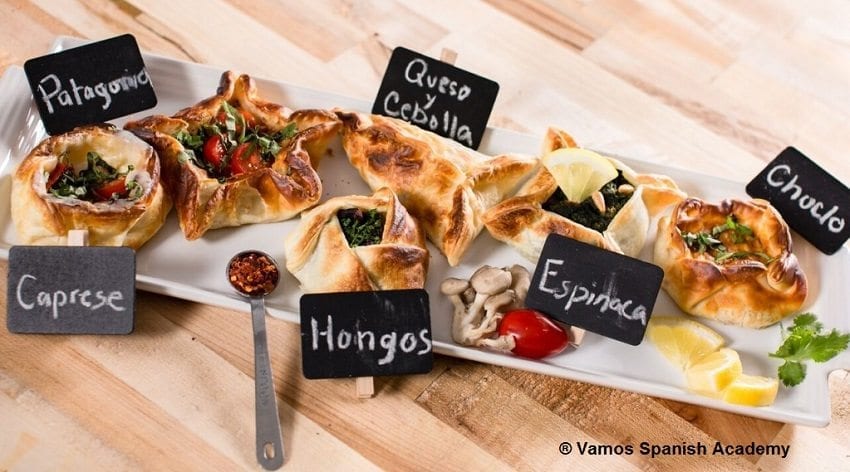This article serves as an authoritative guide on Argentine empanadas, offering a thorough exploration of their types, recipes, and historical significance. It presents an all-encompassing overview designed to enhance your understanding and appreciation of this quintessential Argentine cuisine. Enjoy!
Table of Contents
- Unwrapping the History of Empanadas: From Medieval Spain to Modern Argentina
- Taste of Nostalgia: The Empanada Rap Ad That’s Unforgettable
- Argentine Empanadas – History, Recipes and Types
- Regional Specialties: Savoring Argentina’s Diverse Flavors
- Empanada Salteña: A Taste of Salta Province
- Decoding Empanada Tucumana: A Festival Favorite
- Discovering the Delicacies of Empanada Riojana
- Empanada Cordobesa: A Symphony of Sweet & Savory
- Patagonian Hearty Treats: Exploring Empanada Patagónica
- Empanada de Corrientes, Misiones and Formosa:
- Empanada Fugazzeta: The Cheesy Buenos Aires Classic
- The Art of Argentine Empanada Dough and Pastry Techniques
- Creative Filling Ideas from Argentina’s Cuisine
- Empanadas Pampeanas:
- Homemade Empanadas: Tips for Crafting the Perfect Argentine Snack
- The Empanada Chronicles: Argentina’s Staple Food in Literature and Culture
- Empanada Events and Festivals
- Empanada Entrerriana:
- Empanadas Cooking Tips and Tricks
- Empanada Variations and Fusion Ideas
Unwrapping the History of Empanadas: From Medieval Spain to Modern Argentina
The savory folds of the empanada cradle a rich tapestry of cultural history that stretches from the Iberian Peninsula to the bustling streets of Buenos Aires. Traversing through time, the empanadas history encapsulates a culinary migration that brought forth the fusion of ingredients and techniques culminating in the creation of numerous argentine empanada recipes.
Taste of Nostalgia: The Empanada Rap Ad That’s Unforgettable
The Iberian Roots and Migration to the New World
Deeply entwined within the Iberian gastronomic narrative, the empanada’s genesis is often recited with nods to the Moorish influence and the ingenious dishes documented in the medieval manuscript “Llibre del Coch”. Their very essence, adorned with Iberian roots of empanadas, speaks of meals that reflect both necessity and invention. As the Spanish and Portuguese explorers embarked on their voyages, the humble empanada traversed oceans, finding a new home in the folds of Argentina’s culinary canvas.
Empanada’s Culinary Evolution across Continents
Through centuries of cultural interplay, empanadas took on myriad forms, adapting their core identity to new landscapes and ingredients. The Spanish and Portuguese colonies of the New World became melting pots for the curation and evolution of the empanada, seeding the roots of what would burgeon into the rich history of argentine empanadas.
Jewish and Moorish Influences and the Empanada’s Journey
The intersection of Jewish and Moorish cuisines within the genesis of the empanada illustrates a blend of ancient traditions and regional adaptations. As mentioned in seminal Jewish texts, empanadas embraced the dietary customs and cooking practices of their respective communities, ultimately shaping a dish that would comfortably sit in the annals of Argentine history and on the plates of today’s epicureans.
| Time Period | Region | Influence on Empanada Development | Resulting Empanada Variations |
|---|---|---|---|
| Medieval Era | Iberian Peninsula | Moorish and Spanish culinary styles | Seafood fillings reflective of local diet |
| 15th-16th Century | Spain and Portugal | Jewish dietary laws and food preservation needs | Introduction of diverse fillings and the ubiquitous dough enclosure |
| 16th-18th Century | South America | Interactions between European colonists and indigenous practices | Development of hearty meat recipes using local ingredients |
| Modern Era | Argentina | Regional preferences and agricultural variations | Expansive range of argentine empanada recipes personalized to each province |
Argentine Empanadas – History, Recipes and Types
The tapestry of Argentine empanadas is woven with threads of culinary innovation and diversity, reflecting a vibrant history that has been meticulously folded into every recipe. From the sun-kissed peaks of the Andes to the windswept plains of Patagonia, each region infuses its character into these beloved savory pastries. Elucidating on the types of Argentine empanadas, one discovers the classic beef empanada, spiced with regional flavors, and the inventive mondongo, offering a taste of tradition with every bite.
Exploring the realm of empanada filling ideas, aficionados are enticed by the chicken empanadas, rich in hearty flavors, while gourmands seeking comfort fare find solace in ham and cheese varieties. Vegetarians aren’t left behind with nutrient-rich spinach and signature corn-based humita ensuring there’s a delectable pocket for every palate. The diversity is further enriched as empanadas come baked to golden perfection or fried to a crispy delight, accommodating both regional customs and personal tastes.
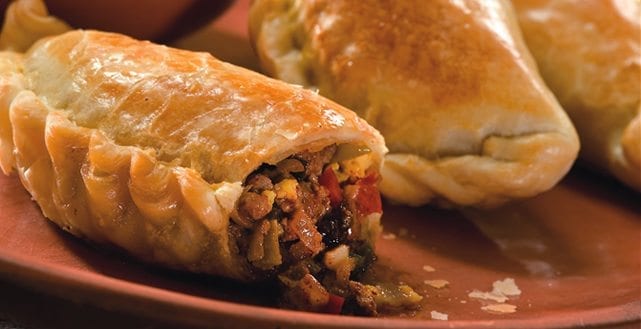

At the heart of Argentina’s cultural festivities, the National Empanada Festival in Tucumán pays homage to this culinary gem. Here, one might unearth the best empanada recipe, a mosaic of local flavors, and a sense of community that turns food into an experience beyond sustenance. The festival is a living museum, exhibiting traditional craftsmanship through the use of indigenous ingredients like peppers, vinegar-infused fillings, and potatoes, blended seamlessly with the iconic empanada dough. This gastronomic jamboree adequately celebrates homemade empanadas – a staple of Argentine passion and pride.
Regional Specialties: Savoring Argentina’s Diverse Flavors
Embark on a culinary journey through Argentina and discover the heart of its gastronomy—traditional argentine empanadas. Each province weaves its own story into these delightful pastries, showcasing regional variations of empanadas that tantalize the palate. An exploration of authentic empanada ingredients and the different types of empanadas reveals the rich cultural tapestry that defines Argentine cuisine.
| Region | Type of Empanada | Key Ingredients | Distinctive Quality |
|---|---|---|---|
| Salta | Empanada Salteña | Beef, potatoes, peppers | Spicy and Juicy |
| Tucumán | Empanada Tucumana | Beef, small in size | Savored during the National Empanada Festival |
| Jujuy | Empanada Jujeña | Goat, llama | Diverse meat fillings |
| Córdoba | Empanada Cordobesa | Sugar-sprinkled, meat or cheese fillings | Sweet-savory profile |
| Catamarca | Empanada Catamarqueña | Meats like venison | Rustic and Hearty |
For example, the renowned empanada salteña is not merely a food item; it is an experience—a spicy and juicy pocket that bursts with the taste of finely chopped beef, tangy potatoes, and vibrant peppers, capturing the essence of Salta’s local fare. On the other hand, Tucumán’s contribution to this culinary diversity is smaller in stature but packed with flavor, playing a starring role in the region’s vibrant food festivals.
In the northern province of Jujuy, food lovers witness the boldness of Argentine empanadas, venturing into fillings of goat and even the exotic llama. And one cannot overlook Córdoba, where the traditional empanada takes a sweet turn with a dusting of sugar. In Catamarca, the fillings venture into wilder territories with lamb and venison, portraying the rugged landscape of the region. The differentiation is clear—regional variations of empanadas are more than just about taste; they are a reflection of each locales’ culture, history, and resources.
Enthusiasts of traditional argentine empanadas will agree that the array of authentic empanada ingredients used reflects the vast agricultural bounty and culinary creativity that Argentina offers. From the warm, northern provinces to the cool southern regions of Patagonia, the humble empanada tells countless stories of regional pride and gastronomic pleasure. In each locale, different types of empanadas provide a delicious glimpse into the local traditions that help define the nation’s identity one bite at a time.
Empanada Salteña: A Taste of Salta Province


Among the pantheon of savory empanadas, the Empanada Salteña stands as a culinary beacon. Hailing from Salta Province, this delicacy encapsulates the robust flavors and rich history of this northern Argentine region, distinguished by a harmonious blend of beef empanadas traditions with local culinary intricacies.
Ingredients and Juicy Fillings Unveiled
To understand the heart of traditional empanada recipes, one must delve into the components that make the Empanada Salteña an unforgettable experience. This provincial specialty brims with a juicy mixture of finely diced beef, paired with the earthy textures of potatoes and peas. Raisins add an unexpected but welcome sweetness, creating a complex flavor profile further accentuated by the smoky warmth of cumin and the vibrant kick of paprika.
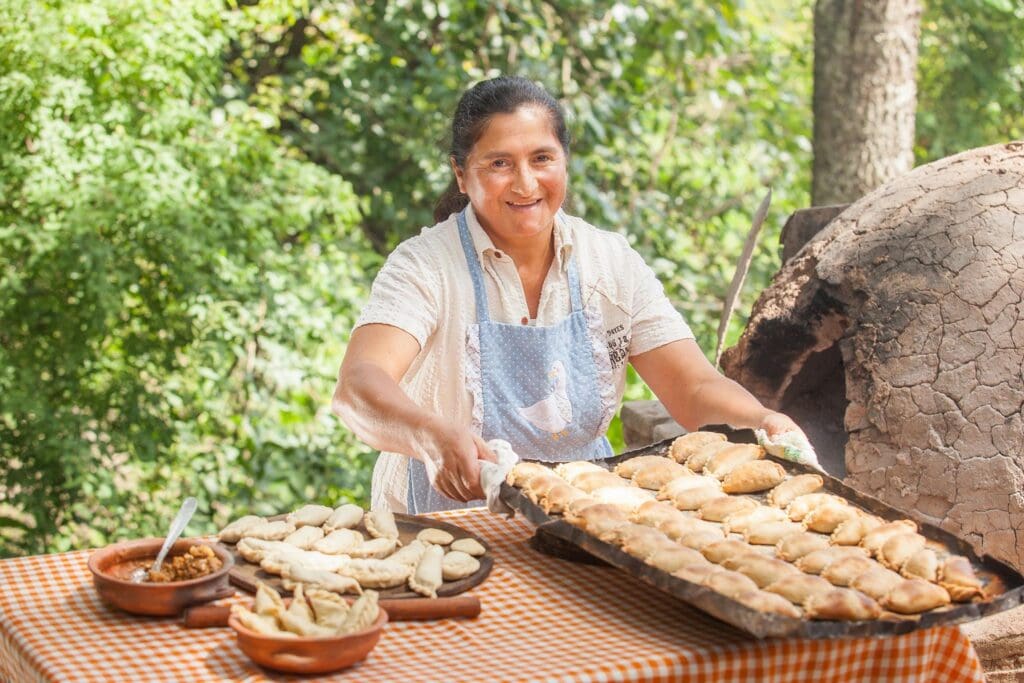

Sweet and Savory Fusion: Culinary Secrets
The allure of these savory empanadas is not just in their filling, but also in the delicate yet sturdy embrace of the empanada dough recipe that holds the flavors together. Achieving the perfect dough is a craft in itself, serving as a vessel that crisps to a golden hue, delivering the quintessential crisp texture that resonates with every bite, giving life to a treasured aspect of Argentine cuisine.
| Ingredient | Role in Empanada Salteña | Origin |
|---|---|---|
| Diced Beef | Main Filling | Salta Province |
| Potatoes and Peas | Texture and Flavor | Local Farms |
| Raisins | Sweetness | Imported |
| Cumin and Paprika | Signature Spices | Regional Blend |
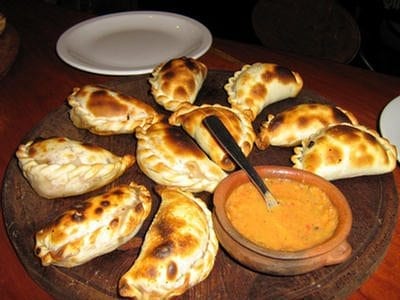

Decoding Empanada Tucumana: A Festival Favorite
Empanada Tucumana, the quintessential favorite at the National Empanada Festival, is more than just a dish—it’s an aromatic journey through the Tucumán province’s rich culinary heritage. Infused with robust green olives, piquant cumin, and paprika, this delight offers a sensory experience with each bite. With its tantalizingly juicy consistency, the empanada Tucumana is known for its smaller size but bolder flavors, combining minced beef, an aromatic mix of onions and spring onions, and the surprising addition of hard-boiled eggs and raisins.
Whether baked to flaky tenderness or fried to crispy perfection, the Empanada Tucumana presents home chefs and festival-goers with the very best empanada filling ideas, all while respecting traditional empanada recipes that have been savored for generations. Cooking aficionados eager to embrace these delectable treats can discover empanada making tips that add a touch of festival charm to their kitchen endeavors, presenting the opportunity to indulge in some of the most popular empanada flavors. Here’s how to craft your own, inspired by Tucumán’s beloved recipes:
- Begin with the finest minced beef—quality ingredients make all the difference.
- Sauté onions and spring onions until they’re just turning golden, releasing their fragrant aroma.
- Add olives, spices, and ancillary ingredients last to preserve their individual flavors.
- Let the mixture cool before building your empanadas to prevent soggy dough.
- Do not overlook the egg wash—it’s the secret to a gorgeous golden finish.
Whether you’re crafting an intimate dinner for two or preparing a fiesta-worthy spread, these Tucumán treats encapsulate the epitome of Argentine flavor, meriting their titled fame as festival favorites. Dive into the world of empanada creation and delight in discovering your personal, preferred blend of traditional tastes and innovative twists.
Discovering the Delicacies of Empanada Riojana
Dive into the hearty taste of La Rioja with its prized Empanada Riojana, where culinary tradition and innovation meet. Notable for its rich combinations that tantalize the palate, this authentic empanada recipe is replete with regional empanada variations that are a cornerstone of La Rioja’s gastronomy. Homemade empanada pastry cradles the robust flavors, paying homage to Argentine heritage while delivering a memorable gourmet experience.
Goat and Lamb Variations: A Rustic Delight
Renowned for their earthy and full-bodied taste, the goat and lamb empanada variations are a testament to La Rioja’s rustic cuisine. These meat options are slowly cooked, tender to the fork, melding with locally sourced spices that envelop each bite in comfort. The homemade empanada pastry holds their sumptuous fillings, offering a perfect bite that resonates with an ode to the pastoral landscapes of the region.
Mild Flavors with Authentic Spices
The Empanada Riojana strikes a delicate balance with its mild flavor profile, achieved through an authentic blend of spices like cumin and paprika. The subtlety of these spices allows the natural flavors of the goat, lamb, potatoes, green onions, and red peppers to shine through in every bite. Skillfully combining these with hard-boiled eggs and raisins results in a signature dish that is both comforting and sophisticated, delivering one of the many beloved regional empanada variations.
Empanada Cordobesa: A Symphony of Sweet & Savory
The culinary tapestry of Argentina presents the Empanada Cordobesa as a masterpiece that skillfully blends sweet and savory notes into an irresistible treat. This delicate balance can only be achieved through the meticulous selection of empanada fillings that create a sumptuous dance of flavors fit for the most discerning of palates.
To fully appreciate the richness of the Empanada Cordobesa, one must delve into the authentic empanada dough that envelopes the delectable filling. Key to this experience is the best empanada dough recipe, a guarded secret among Argentinian chefs, which often includes a dollop of sugar to achieve the perfect crust that is as much a treat as the filling itself.
- Ground beef or pork represents the robust savory base.
- Chopped onions and green olives provide a piquant contrast, playing up the flavors.
- A sprinkle of sugar is the coup de grâce that introduces a subtle sweetness, catching the senses by surprise.
- Cumin and paprika infuse the empanada with a distinctive aroma and warmth that is quintessentially Argentinian.
Whether enjoyed as a sweet empanada closure to a meal or as a savory snack, the Empanada Cordobesa remains a testament to Argentina’s rich culinary expertise. Its unmistakable charm lies in the harmonious union of sweet and savory, a signature of Córdoba’s gastronomic identity.
Patagonian Hearty Treats: Exploring Empanada Patagónica
The southernmost reaches of Argentina present food lovers with the hearty and flavorful Empanada Patagónica. A culinary gem from this windswept region, these empanadas redefine traditional Argentine cuisine, infusing it with local traditions and gastronomic innovation. Homemade empanada variations from Patagonia are particularly renowned for their rich, meaty fillings and the unique spin on empanada dough variations.


Lamb and Venison Fillings
Typical ingredients found in a traditional Patagonian empanada include succulent lamb and wild venison, deeply rooted in the region’s pastoral and hunting culture. Not only do these protein choices provide a robust foundation for the fillings, but also bring to the table a taste of Patagonia’s expansive landscapes and outdoors traditions. Often mingled with onions, green olives, and bell peppers, and seasoned with cumin and paprika, the lamb empanadas reflect Patagonia’s culinary diversity and richness.
Unique Characteristics of Southern Argentine Empanadas
Reflected in both their substance and their style, empanadas from Patagonia exhibit notable traits that distinguish them from other regional delights. Let’s delve into some of these characteristics with a detailed comparison:
| Feature | Empanada Patagónica | Traditional Argentine Empanadas |
|---|---|---|
| Filling | Lamb, venison, onions, olives, red peppers, spices | Beef, chicken, ham, cheese, varied vegetables, spices |
| Dough | Hearty, occasionally includes regional flours or fats | Flaky, butter or lard-based, more standardized |
| Cooking Method | Often baked, suited for the meat’s slow-cooking needs | Both baked and fried, depending on regional preference |
| Spices | Robust use of cumin, paprika, sometimes native herbs | Varied but generally a lighter hand on spices |
| Cultural Significance | A showcase of Patagonian pastoral identity and ruggedness | Reflective of Argentina’s broader culinary mosaic |


The exploration of these homemade empanada variations offers much more than a tasty bite; it invites us to savor the deep-rooted traditions and locally-inspired innovations that are the hallmark of Patagonia’s food culture. Every bite of these hearty empanadas is a gastronomic journey through the southern landscapes of Argentina.
Empanada de Corrientes, Misiones and Formosa:
Up north in Corrientes, Misiones, and Formosa, the empanadas are sometimes made with mandioc or cassava flour.
Argentina’s culinary landscape is as diverse as its geography, with each region offering its own unique spin on classic dishes. The provinces of Corrientes, Misiones, and Formosa, located in the northeastern part of the country, are no exception. They each have their distinct take on the beloved empanada, showcasing the rich gastronomy of this region. In this article, we will delve into the scrumptious world of Empanadas de Corrientes, Misiones, and Formosa, revealing the flavors that set them apart from other variations across Argentina.
Empanada de Corrientes: Empanadas from Corrientes are known for their generous filling, which typically consists of diced or minced beef, onions, bell peppers, and hard-boiled eggs. The meat is seasoned with a blend of spices, such as cumin, paprika, and black pepper. One unique feature of Empanadas de Corrientes is that they often include a piece of pork fat, which adds extra flavor and moisture to the filling. These empanadas are usually baked, resulting in a crispy and flaky pastry.
Empanada de Misiones: In Misiones, empanadas are influenced by the flavors and ingredients of the region. The filling often includes cassava (also known as yuca or manioc), a starchy root vegetable that is a staple in the local cuisine. The cassava is typically combined with ground beef, onions, and bell peppers, seasoned with a mix of spices such as garlic, oregano, and chili powder. Empanadas de Misiones can be either baked or fried, depending on personal preference, and are characterized by a slightly thicker dough compared to other empanadas.
Empanada de Formosa: Empanadas from Formosa are known for their filling made with “mbopi,” a mixture of finely chopped vegetables such as onions, bell peppers, and tomatoes. The filling also includes minced beef, which is seasoned with spices like cumin, paprika, and salt. The dough for Empanadas de Formosa is slightly thinner than that of other empanadas, allowing the flavors of the filling to shine through. These empanadas are usually fried, giving them a golden and crunchy exterior.


Empanada Fugazzeta: The Cheesy Buenos Aires Classic
Delving into the heart of Buenos Aires’ gastronomy, one cannot overlook the sumptuous cheese empanadas, particularly the renowned Empanada Fugazzeta. This culinary creation has its roots interlinked with the iconic Fugazzeta pizza. The cheese empanada, a vegetarian delight, is laden with creamy mozzarella and sharp provolone, intermingled with softly sautéed onions. A whisper of oregano and a pinch of black pepper are all that’s needed to elevate the flavors synonymous with Argentinian comfort food.
As both a versatile dish and a quintessential component of Argentine empanada recipes, the Empanada Fugazzeta can be prepared with an assortment of dough types, from the classic crumbly pastry to a flakier puff pastry base. Herein lies the versatility that makes empanada recipes so beloved. Below is a guide that outlines the essentials for creating the ultimate Empanada Fugazzeta, ensuring a gastronomic journey right to the cobblestoned streets of Buenos Aires.
| Ingredient | Quantity | Notes |
|---|---|---|
| Mozzarella Cheese | 2 cups, shredded | Melt-friendly for gooey goodness |
| Provolone Cheese | 1 cup, shredded | Gives a sharp, tangy flavor |
| Onions | 2 medium, thinly sliced | Softened via sautéing |
| Oregano | 2 tsp, dried | For an herbaceous aroma |
| Black Pepper | To taste | Freshly cracked for best flavor |
| Empanada Dough | Sufficient for 12 empanadas | Traditional or puff pastry options |
The process is straightforward – the cheeses and onions represent the stars of the filling, with the dough acting as the perfect stage for the melting, flavorful performances within. Notably, these vegetarian empanadas reflect Buenos Aires’ innovative approach to food, a testament to the rich, comforting, and diverse repertoire of Argentine empanada recipes. Whether enjoyed as a snack or a shared meal, the Empanada Fugazzeta promises to captivate the palates of cheese aficionados and Argentine cuisine lovers alike.


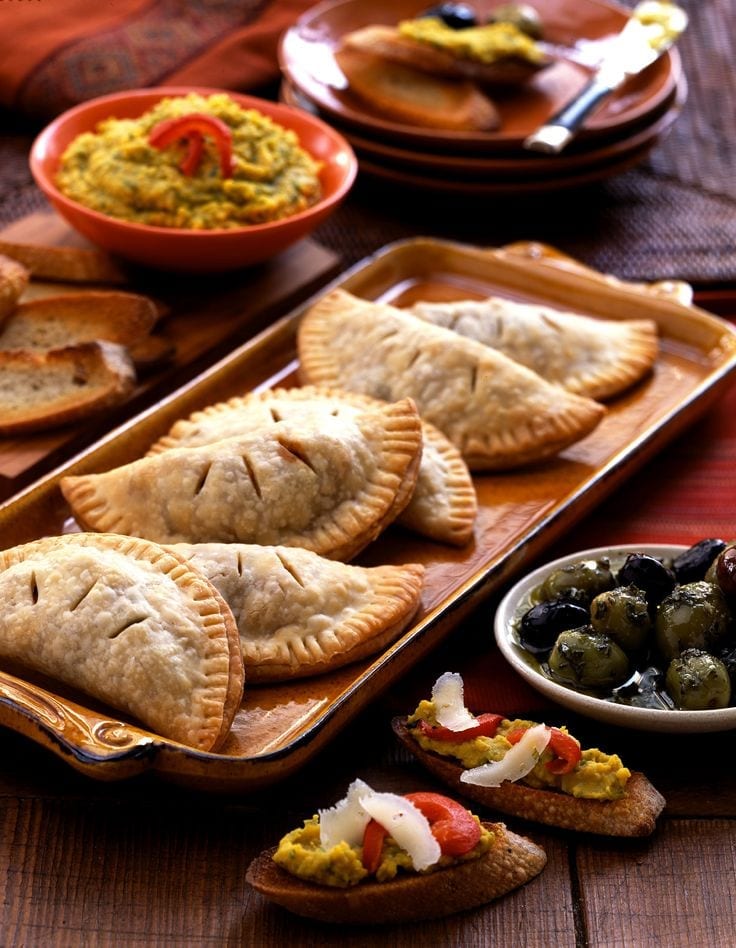

The Art of Argentine Empanada Dough and Pastry Techniques
Embarking on the journey to create the quintessential Argentine empanada begins with mastering the craft of the dough. The secret to an authentic empanada experience lies within the delicate balance of ingredients and the handling of the dough. Each step from preparation to the final cooking technique contributes to the signature texture and taste that epitomize these beloved pastries.
Finding the Perfect Empanada Dough Recipe
The quest for homemade empanada dough that mirrors Argentina’s best begins in the kitchen. The ingredients are simple – flour, water, and fat – but proportions and mixing methods vary, bringing subtle yet distinct results. Butter often lends a richer flavor while lard provides a crumbly, short texture. Argentinian homes treasure their family recipes, passing them down through generations, each claiming to have the best empanada variation.
Baking vs. Frying: What Makes the Difference?
When it’s time to cook, the decision to bake or fry can deeply influence the final product. Baked empanadas showcase a flaky, tender crust, a hallmark of many empanada baking techniques. In contrast, frying plunges the pastries into a bath of hot oil, creating a golden jewel with a crisp exterior and an irresistibly moist interior. The choice sets the stage for how to make Argentine empanadas that truly resonate with culinary enthusiasts.
For those eager to replicate these techniques, below is a table comparing baked and fried empanada characteristics that could guide the home cook toward achieving their preferred outcome:
| Baking | Frying |
|---|---|
| Light, flaky texture | Crunchy, golden exterior |
| Subtle dough flavor, allowing fillings to shine | Rich taste from fat absorption |
| Typically lower in fat and calories | A more indulgent option with a higher fat content |
| More consistent shape and color | Varied shades of golden brown depending on frying time |
| Requires precise oven temperature control | Demands attention to oil temperature and frying time |
| Ideal for doughs with higher fat content | Perfect for a moist and savory experience |
Aspiring chefs and seasoned cooks alike will find that the beauty of Argentine empanadas resides not just in the vast possibilities of fillings, but also in the nuanced pastry approaches they select. Whether baked or fried, these tips on how to make Argentine empanadas are designed to guide through the rewarding process of transforming simple ingredients into delectable masterpieces.
Creative Filling Ideas from Argentina’s Cuisine
Embracing the art of Argentine cooking, empanadas serve as a canvas for an array of intricate and satisfying fillings. The custom of matching flavors to local tradition results in a culinary exploration that takes your palate across the very provinces of Argentina. Here, we delve into the myriad options for empanada lovers, exploring the traditional staples and innovative combinations that make Argentine empanadas a gastronomic delight.
Beef, Chicken, and Vegetarian Options
In every corner of Argentina, chicken empanadas seduce with their tenderness and spice, while hearty beef fillings remain a classic choice, beloved for their robust flavor. For those pursuing a plant-based diet or simply seeking a lighter fare, vegetable empanadas are a verdant treasure trove of flavors, with fillings like roasted bell peppers, sweet corn, and aromatic herbs.
Authentic Empanada Fillings: Regional Influences
The distinctiveness of each region’s empanadas is often celebrated; the infusion of regional tastes into homemade empanada fillings is a testament to Argentina’s diverse culinary landscape. These popular empanada variations not only honor local produce but also represent the cultural fusing that has occurred through Argentina’s history.
| Region | Meat-Based Fillings | Vegetarian Fillings |
|---|---|---|
| Buenos Aires | Classic beef with green olives and eggs | Fugazzetta with mozzarella and onions |
| Salta | Spicy beef with potato and pepper | Humita with sweet corn and cheese |
| Córdoba | Perro with beef, egg, and a touch of cinnamon | Sweet pumpkin with a hint of spice |
| Tucumán | Minced beef with spring onions and boiled egg | Spinach and ricotta with nutmeg |
| Patagonia | Lamb or venison with red peppers | Wild mushroom with thyme |
Whether you’re savoring a meat-packed empanada in the shadow of the Andes or enjoying a cheese-stuffed offering on the bustling streets of Buenos Aires, the intersection of local ingredients and generational knowledge ensures each bite is a tribute to Argentine pride and gastronomy.
Empanadas Pampeanas:
La Pampa has empanadas that reflect the tastes of its neighbours (Buenos Aires, Córdoba, Mendoza, Patagonia); fillings commonly include red peppers, carrots, hard-boiled egg, and currants.
Argentina’s vast Pampas region, known for its fertile plains and abundant agricultural production, has also given rise to a unique variation of the beloved empanada: the Empanada Pampeana. The Pampas, which include parts of the provinces of Buenos Aires, La Pampa, Santa Fe, Córdoba, and Entre Ríos, provide the ideal setting for a rich culinary tradition that combines the flavors of the heartland with influences from European immigrants. In this article, we’ll explore the distinct characteristics of Empanadas Pampeanas, which showcase the region’s gastronomic heritage and the bounty of its fertile plains.
The Empanada Pampeana: Empanadas Pampeanas are characterized by their simple yet flavorful filling, made primarily from minced or diced beef, onions, and green onions. The beef, which is often sourced from the region’s renowned cattle farms, is seasoned with a blend of spices, such as cumin, paprika, and black pepper, giving it a subtle yet savory taste. Sometimes, the filling is enriched with the addition of hard-boiled eggs or olives, adding an extra layer of flavor and texture to the dish.
One of the defining features of Empanadas Pampeanas is their thin and flaky dough, which is made from wheat flour, water, and fat, such as lard or shortening. This delicate pastry envelops the savory filling, creating a harmonious balance of flavors and textures that is both satisfying and delicious.
Preparing Empanadas Pampeanas: To make Empanadas Pampeanas, the wheat flour dough is rolled out and cut into circles, which are then filled with the seasoned beef mixture. The dough is folded over the filling, and the edges are carefully crimped to create the traditional “repulgue” seal, which not only helps to secure the filling but also adds an attractive touch to the finished empanada.
Cooking Methods: Empanadas Pampeanas are typically baked in the oven, resulting in a golden and flaky pastry that is both crispy and tender. The delicate dough is well-suited for baking, as it allows the flavors of the filling to shine through without being overwhelmed by a heavy crust.
Serving Empanadas Pampeanas: These delectable pastries can be enjoyed as an appetizer, snack, or main course, and they are perfect for sharing with friends and family. Empanadas Pampeanas are often served with a side of chimichurri sauce, a tangy and slightly spicy condiment made from parsley, garlic, vinegar, oil, and spices, which adds an extra depth of flavor to the dish.


Homemade Empanadas: Tips for Crafting the Perfect Argentine Snack
Empanadas, the quintessential Argentine treat, have a special place both in the hearts of locals and food lovers globally. Making authentic empanadas at home can transport you to the vibrant streets of Buenos Aires with every bite. The journey to crafting these delectable pastries involves a symphony of traditional techniques and a splash of personal culinary flair. Below, you’ll discover the essential steps and techniques to help you master the art of empanada making.
Step-by-Step Guide to Making Empanadas at Home
- Select Your Filling: Begin with an authentic empanada recipe. Whether you’re leaning towards a classic beef, spicy chicken, or a vegetarian option, ensure your ingredients are fresh and your spices reflect the flavors of Argentina.
- Make the Dough: Aim for a homemade empanada pastry that’s soft yet durable enough to hold your chosen fillings without tearing. This balance is crucial for creating the perfect empanada crust.
- Fill and Fold: Evenly distribute the filling, avoiding overfilling, which can lead to ruptures during cooking. Fold the dough over the filling and press the edges to seal.
- Crimp the Edges: Master the repulgue, the traditional crimping technique, by pinching and folding the edges. This not only seals the empanadas but also gives them their iconic look.
- Cook to Perfection: Bake or fry the empanadas based on your preference or the specific style of the recipe you’re following. The goal is a golden-brown crust with a deliciously hot filling.
Culinary Techniques from Argentine Kitchens
Authenticity in empanada making tips isn’t just about following a recipe but also embracing the culinary culture behind it. Here’s how you can bring a slice of Argentina into your kitchen:
- Seasoning: Don’t hold back on the paprika, cumin, and oregano. These spices are the lifeblood of many authentic empanada recipes.
- Cooking Method: If possible, try using a clay oven to bake your empanadas, as it imparts a rustic flavor that’s hard to replicate with modern ovens.
- Dough Hydration: Ensure your dough has the right hydration level. Argentinian kitchens emphasize a dough that’s neither too dry nor too sticky.
- The Art of Repulgue: Perfecting the crimping technique can take time, but it’s a sign of a well-made empanada and prevents filling from spilling out.
- Resting the Dough: Allow the dough to rest before rolling it out. This step is crucial for a tender and flaky crust.
The Empanada Chronicles: Argentina’s Staple Food in Literature and Culture
As a culinary icon and a pillar of Argentine pride, the empanada’s tale is rich and complex, woven through the fabric of the nation’s identity and history. The genesis and evolution of empanada history is a storied journey from immigrant kitchens to the illustrious pages of Argentine literature, depicting the omnipresence of this beloved dish in the collective memory of the country. With each fold of dough and spiced filling, these ubiquitous pastries carry the essence of Argentina – from the quaint cobblestone streets of San Telmo to the bustling kitchens of native homes.
In the realm of cultural representation, argentine empanada recipes have emerged as illustrious ambassadors of the country’s gastronomy. Celebrated in story and song, the empanada encapsulates more than flavors; it embodies the blend of indigenous traditions and immigrant influences that define Argentine society. From region to region, the assortment of argentinian empanada varieties mirrors the nation’s diverse landscapes and cultural influences. Each province adds its signature twist to the classic recipes – a portrayal of its unique history and customs.
Their remarkable adaptability and widespread popularity make empanadas a focal point for a culture trip through Argentina, offering a savory exploration of local lifestyles and traditions. Recognized by the Argentine Ministry of Culture, the empanada stands as an emblem of food heritage, an edible incarnation of the spirit of the people. These pockets of pleasure are not just a feast for the palate; they are narrators of Argentina’s rich cultural tapestry, a feast worthy of epicurean and anthropological acclaim.
Empanada Events and Festivals
Empanada lovers can celebrate their passion by attending events and festivals dedicated to these delicious treats. Some notable events include:
- National Empanada Day: Held on April 8th in Argentina, this day celebrates the rich history and cultural significance of empanadas. Various restaurants and bakeries offer special deals or promotions to mark the occasion.
- Empanada Festival: An annual event in different cities across Argentina, featuring empanada-making competitions, live music, and the chance to sample a variety of empanadas from local vendors.
- World Empanada Championship: A global competition where professional chefs and home cooks present their unique empanada recipes, showcasing the versatility and creativity of this beloved dish.
Attending these events allows you to discover new empanada recipes, learn from skilled cooks, and indulge in a shared love for these delightful pastry pockets.
Empanada Entrerriana:
Entre Rios has a special empanada that is stuffed with milk-soaked rice. They are also typically made with a wheat flour dough, which is rolled out and cut into circles. The filling usually consists of ground or chopped beef, onions, bell peppers, olives, hard-boiled eggs, and a combination of spices, such as cumin, paprika, and salt. Some variations may include chicken or other meats. The dough circles are then filled, folded in half, and sealed by crimping the edges to create a decorative border called “repulgue.”
Empanadas from Entre Ríos can be either baked or fried, depending on personal preference. They are often served with a side of chimichurri sauce, a blend of parsley, garlic, vinegar, oil, and spices, which adds an extra layer of flavor to the dish.
Like other regional empanadas in Argentina, those from Entre Ríos have their own unique characteristics, but all share the essential foundation of a delicious pastry filled with a flavorful mixture of ingredients.


| Empanada Type | Filling Ingredients | Dough/Crust | Region | Unique Characteristics |
|---|---|---|---|---|
| Empanada Salteña | Diced beef or chicken, potatoes, peas, hard-boiled egg, olives, raisins, cumin, paprika | Traditional empanada dough | Salta | Juicy filling; often spicy; features a mix of sweet and savory flavors |
| Empanada Tucumana | Minced beef, onions, green onions, green olives, hard-boiled egg, raisins, cumin, paprika | Traditional empanada dough | Tucumán | Smaller in size; juicy filling; can be baked or fried |
| Empanada Riojana | Goat or lamb meat, potatoes, green onions, red pepper, hard-boiled egg, raisins, cumin, paprika | Traditional empanada dough | La Rioja | Features goat or lamb meat; mild flavor |
| Empanada Cordobesa | Ground beef or pork, onions, green olives, raisins, hard-boiled egg, sugar, cumin, paprika | Traditional empanada dough | Córdoba | Sweetened with sugar; unique sweet and savory flavor combination |
| Empanada Patagónica | Lamb or venison, onions, green olives, red pepper, hard-boiled egg, cumin, paprika | Traditional empanada dough | Patagonia | Made with regional meats like lamb or venison; hearty filling |
| Empanada Fugazzeta | Mozzarella cheese, provolone cheese, sautéed onions, oregano, black pepper | Traditional empanada dough or puff pastry dough | Buenos Aires | Cheese and onion filling, similar to popular “Fugazzeta” pizza style |
Interested in Spanish Classes? Check our Spanish School Malaga
Empanadas Cooking Tips and Tricks
To create mouthwatering empanadas, follow these tips and tricks to ensure success:
- Dough consistency: The dough should be smooth and elastic, not too sticky or dry. Knead it well to develop the gluten and allow it to rest for at least 30 minutes before rolling out. This will help prevent the dough from shrinking when baked or fried.
- Empanada folding: There are various folding techniques, such as the classic “repulgue” or rope edge, the fork crimp, and the half-moon shape. Practice different folding methods to find one that works best for you and creates a secure seal to keep the filling inside.
- Don’t overstuff: While it’s tempting to add a generous amount of filling, overstuffing can lead to broken empanadas during cooking. Use just enough filling to comfortably close the dough without stretching it too thin.
- Keep fillings dry: Excess moisture in the filling can make the dough soggy and difficult to handle. Cook your fillings thoroughly and allow them to cool before using, draining any excess liquid.
- Baking vs. frying: Baking empanadas gives them a lighter, flakier texture, while frying creates a crispy, golden crust. Choose the method that best suits your taste and dietary preferences.
Empanada Variations and Fusion Ideas
Experiment with innovative fillings inspired by different cuisines to put a unique twist on the traditional Argentine empanada:
- Asian fusion: Combine flavors from Chinese or Japanese cuisine by using fillings like teriyaki chicken, pork belly, or shrimp and vegetables.
- Mediterranean inspiration: Use ingredients like feta cheese, spinach, sun-dried tomatoes, or roasted eggplant for a Mediterranean twist.
- Indian flavors: Incorporate ingredients such as spiced potatoes, peas, and paneer, or try a chicken tikka masala filling for an Indian-inspired empanada.
- Tex-Mex fusion: Mix ground beef, beans, jalapeños, and cheddar cheese for a Tex-Mex style empanada, or create a vegetarian version with black beans, corn, and avocado.


Maria Olson
At VAMOS Academy, I craft stories sprinkled with my love for exploration and food. Whether it’s the tang of a local dish or the rhythm of a new dialect, I bring these experiences to you. Ready for an adventure that tickles your taste buds and ignites your wanderlust? Let’s embark on this journey together, one story and one bite at a time.
So that’s an overview of the empanadas you’re likely to encounter during your travels in Argentina – be sure to try one in every province that you visit. Come and join us for a Tango Lesson in Buenos Aires and Yoga Classes
For more information about Empanadas visit our Buenos Aires Spanish School Website https://vamospanish.com or visit us at Viamonte 1516, C1055ABD, C1055 ABD, Buenos Aires, Argentina Call Us Toll-Fee +1 888-808-1242 Arg Arg +54 11 5984-2201 Instituto de Ingles
Школа испанского языка в Аргентине
école d’espagnol à Buenos Aires
Spaans Leren in Buenos Aires
Lerne Spanisch In Buenos Aires
escola de espanhol em Buenos Aires
Clases de Español para extranjeros
Clases de Frances
Hey there! I’m Maria Olson, your go-to nomad with a suitcase in one hand and a pen in the other, forever caught in the dance of Buenos Aires’ energy and Malaga’s serene vibes. My life’s an open book of travels, stitched together by the countless cultures I’ve embraced and the languages that now flow from my tongue as easily as my native speech. Speaking Spanish, English, French, German, and Russian isn’t just a party trick; it’s my way of unlocking the world’s secrets, one conversation at a time.
But let’s talk about the real spice of life—food. My adventures are nothing without the flavors I’ve savored and the culinary treasures I’ve unearthed along the way. Whether it’s diving into Argentina’s vibrant markets or sipping on sangria in a hidden corner of Spain, I bring these experiences to the table, sharing a slice of the world through my tales.
Crafting blogs for VAMOS Academy, I blend my wanderlust with a dash of creativity to serve up content that’s as unique as the journeys that inspired them. So, if you’re itching for adventure, hungry for a taste of the unknown, or simply curious about the art of language, you’re in good company.
